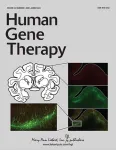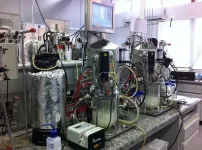(Press-News.org) In addition to an antigen, many vaccines also contain substances, called adjuvants, which stimulate the immune system. By using computer-aided molecular design and machine learning, a Chinese research team has now developed two novel broad-spectrum adjuvants that can significantly amplify the immune response to vaccines. As reported in the journal Angewandte Chemie, they were able to enhance the effectiveness of immunization against certain forms of cancer in animal models.
Adjuvants amplify and prolong the effect of vaccine immunizations. Aluminum salts have been successfully used as adjuvants for many decades. Alternatively, there are oil-in-water emulsions that target pattern recognition receptors on immune cells. However, older versions of this type of adjuvant were not effective enough or had troublesome side effects. Newer versions are well-tolerated and effective but need to be tailored for every individual vaccine.
By using computer-aided molecular design and machine learning, Bing Yan, Sijin Liu, and their team at the Research Center for Eco-Environmental Sciences and the Capital Medical University in Beijing, as well as the University of Chinese Academy of Sciences in Beijing and Hangzhou, the Shandong First Medical University & Shandong Academy of Medical Sciences, and the Guangzhou University, have now developed two novel adjuvants with broad-spectrum effectiveness that can significantly boost the immune response to vaccines.
The new adjuvants are designed to bind to toll-like receptors (TLR), a class of proteins used by dendritic cells to detect the characteristic molecular patterns of pathogens. If an “enemy” is recognized, the dendritic cell moves into a lymph node and “presents” its find to the T-cells. These activated T-cells then multiply and enlist further immune cells in the fight.
The team identified structural characteristics of the binding sites on human TLR and developed a collection, a substance library, with 46 different ligands that are compatible with the binding site. The special twist in this case is that these ligands are anchored to the surfaces of biocompatible gold nanoparticles. This causes them to be bound more easily by the TLR. Two of the ligands were found to be especially effective. Comprehensive in vitro, ex vivo, and in vivo studies demonstrated that they bind to several different TLR and increase the activation of dendritic cells, presentation of antigens to T-cells, and their activation.
Mice treated with tumor-specific antigens plus one of these new adjuvants demonstrated strong immune responses that suppressed tumor growth and lung metastases after implantation of specific cancer cells.
Adjuvants further optimized through this method could reduce the problem of decreasing immunity for current vaccines and perhaps make booster vaccines unnecessary. Their use in immunotherapy to treat cancer is also highly promising.
(2991 characters)
About the Author
Bing Yan is the Cheung Kong Scholar Professor at Guangzhou University. He is a fellow of the Royal Society of Chemistry. His research interests are environmental impacts on health, drug discovery, nanomedicine, and nanotoxicology.
END
Making immunizations more effective
Adjuvants developed using computers boost vaccines
2023-03-27
ELSE PRESS RELEASES FROM THIS DATE:
JWST confirms giant planet atmospheres vary widely
2023-03-27
ITHACA, N.Y. – An international team of astronomers has found the atmospheric compositions of giant planets out in the galaxy do not fit our own solar system trend.
Using NASA’s James Webb Space Telescope (JWST), the researchers discovered that the atmosphere of exoplanet HD149026b, a ‘hot Jupiter’ orbiting a star comparable to our sun, is super-abundant in the heavier elements carbon and oxygen – far above what scientists would expect for a planet of its mass.
These findings, published in “High atmospheric metal enrichment for a Saturn-mass ...
Breakthrough Brain Imaging: Experts use new microscope, AI algorithm, and voltage indicators to image electrical activity deep in the brain
2023-03-27
When studying the brain, researchers are just beginning to use a method known as voltage imaging to track neural activity in the living animal. While this approach is a promising way to better understand neuron firing, behavior, and cognition, there are limitations and risk factors. The practice requires putting a lot of light into the brain (which can lead to overheating) and only has the capacity to image ten neurons at a time.
New research from Jerry Chen, a Boston University College of Arts & Sciences assistant professor of biology, and collaborators aims to address these challenges. Published today in Nature Methods, ...
RIT researcher receives funding to improve infrastructure safety for nuclear waste disposal
2023-03-27
Researchers at Rochester Institute of Technology are investigating the combined physical effects of heat, chemical reactions, and seismic activity on concrete lining structures used to dispose of nuclear waste. Results from the work could improve nuclear waste infrastructure designs, better long-term safety management, and refine strategies to meet climate change targets.
Lu Sun, a professor in RIT’s College of Engineering Technology (CET), received a grant of nearly $500,000 from the Nuclear Regulatory Commission for “High temperature and seismic response of concrete lining structures and clay in nuclear waste disposal.” ...
NASA’s Webb measures the temperature of a rocky exoplanet
2023-03-27
An international team of researchers has used NASA’s James Webb Space Telescope to measure the temperature of the rocky exoplanet TRAPPIST-1 b. The measurement is based on the planet’s thermal emission: heat energy given off in the form of infrared light detected by Webb’s Mid-Infrared Instrument (MIRI). The result indicates that the planet’s dayside has a temperature of about 500 kelvins (roughly 450 degrees Fahrenheit) and suggests that it has no significant atmosphere.
This is the first detection of any form of light emitted by an exoplanet as small and as cool as the rocky planets in our own solar system. The result ...
Benefiting from orphan drug and rare pediatric disease designations for gene therapy
2023-03-27
Providing an overview of the submissions process and examples of U.S. Food and Drug Administration (FDA) applications for Orphan Drug Designation (ODD) and Rare Pediatric Disease Designation (RPDD), a new article can help developers of gene therapies for rare genetic diseases. The article is published in the peer-reviewed journal Human Gene Therapy. Click here to read the article now.
Anne Pariser and Elizabeth Ottinger, from the National Center for Advances in Translational Sciences (NCATS), National Institutes of Health, and coauthors, describe the ODD and RPDD programs, which provide financial incentives for the development of ...
Study paves way to more efficient production of 2G ethanol using specially modified yeast strain
2023-03-27
A Brazilian study paves the way to increased efficiency of second-generation (2G) ethanol production based on the discovery of novel targets for metabolic engineering in a more robust strain of industrial yeast. An article on the study is published in the journal Scientific Reports.
The databases compiled by the authors are at the disposal of the scientific community in the repository of the State University of Campinas (UNICAMP), which is a member of the Dataverse Project, an international collaborative initiative supported by FAPESP.
First-generation (1G) ethanol is produced from sources rich in carbohydrates ...
UC Davis Health collaborates with Propeller Health to improve clinical outcomes of COPD patients
2023-03-27
UC Davis Health and Propeller Health have announced a new collaboration that will offer personalized treatment for high-risk patients with asthma and chronic obstructive pulmonary disease (COPD) aiming to improve their health outcomes.
As part of the collaboration, UC Davis Health will provide the Propeller program – including sensors, mobile app, web portal, and personalized support – to eligible patients, with eventual expansion to patients in other UC locations and UC affiliates. The sensors attach to a patient’s inhaler to capture unique signals that record events, such as ...
Largest study to date of minipuberty identifies two new patterns of the reproductive hormone, AMH, in infant girls
2023-03-27
Minipuberty is a stage of reproductive development during infancy in both sexes when reproductive hormones change and reproductive organs develop. The importance of minipuberty is not well understood but could represent an opportunity for the early identification of future reproductive conditions and enable prompt treatment. Anti-Müllerian hormone (AMH) is one of the hormones that changes during minipuberty, and it plays a key role in the development of reproductive organs in boys. However, the role of AMH in infant girls is less clear.
In ...
Bomb-sniffing rodents undergo ‘unusual’ reproductive transformations
2023-03-27
ITHACA, N.Y. – Female giant African pouched rats, used for sniffing out landmines and detecting tuberculosis, can undergo astounding reproductive organ transformations, according to a new study.
The paper, “Extreme plasticity of reproductive state in a female rodent,” which published March 27 in Current Biology, explores how traits once considered “fixed” in adult animals may become variable under specific pressures.
Though these rodents could have important military, biodetection and humanitarian uses, breeding them at high rates has been a challenge. ...
ENGOT-EN6-NSGO/GOG-3031/RUBY trial results: The new standard of care in advanced/recurrent endometrial cancer
2023-03-27
EMBARGO DATE: Monday, March 27, 2023, 12:30 pm ET
PRESS RELEASE
ENGOT-EN6-NSGO/GOG-3031/RUBY trial results:
The new standard of care in advanced/recurrent endometrial cancer
ENGOT, NSGO-CTU & GOG-Foundation proudly announce the ground-breaking results of ENGOT-EN6-NSGO/GOG-3031/RUBY trial.
The results reveal improvement in overall survival at 24 months in whole study population from 56% (CP+placebo) to 71.3% (CP+dostarlimab). “although these are interim data, we believe they are robust and will be confirmed with longer follow-up.”, said Mansoor R Mirza.
The trial is presented on 27th of March 2023 through ESMO’s ...
LAST 30 PRESS RELEASES:
Neuroscientists devise formulas to measure multilingualism
New prostate cancer trial seeks to reduce toxicity without sacrificing efficacy
Geometry shapes life
A CRISPR screen reveals many previously unrecognized genes required for brain development and a new neurodevelopmental disorder
Hot flush treatment has anti-breast cancer activity, study finds
Securing AI systems against growing cybersecurity threats
Longest observation of an active solar region
Why nail-biting, procrastination and other self-sabotaging behaviors are rooted in survival instincts
Regional variations in mechanical properties of porcine leptomeninges
Artificial empathy in therapy and healthcare: advancements in interpersonal interaction technologies
Why some brains switch gears more efficiently than others
UVA’s Jundong Li wins ICDM’S 2025 Tao Li Award for data mining, machine learning
UVA’s low-power, high-performance computer power player Mircea Stan earns National Academy of Inventors fellowship
Not playing by the rules: USU researcher explores filamentous algae dynamics in rivers
Do our body clocks influence our risk of dementia?
Anthropologists offer new evidence of bipedalism in long-debated fossil discovery
Safer receipt paper from wood
Dosage-sensitive genes suggest no whole-genome duplications in ancestral angiosperm
First ancient human herpesvirus genomes document their deep history with humans
Why Some Bacteria Survive Antibiotics and How to Stop Them - New study reveals that bacteria can survive antibiotic treatment through two fundamentally different “shutdown modes”
UCLA study links scar healing to dangerous placenta condition
CHANGE-seq-BE finds off-target changes in the genome from base editors
The Journal of Nuclear Medicine Ahead-of-Print Tip Sheet: January 2, 2026
Delayed or absent first dose of measles, mumps, and rubella vaccination
Trends in US preterm birth rates by household income and race and ethnicity
Study identifies potential biomarker linked to progression and brain inflammation in multiple sclerosis
Many mothers in Norway do not show up for postnatal check-ups
Researchers want to find out why quick clay is so unstable
Superradiant spins show teamwork at the quantum scale
Cleveland Clinic Research links tumor bacteria to immunotherapy resistance in head and neck cancer
[Press-News.org] Making immunizations more effectiveAdjuvants developed using computers boost vaccines




